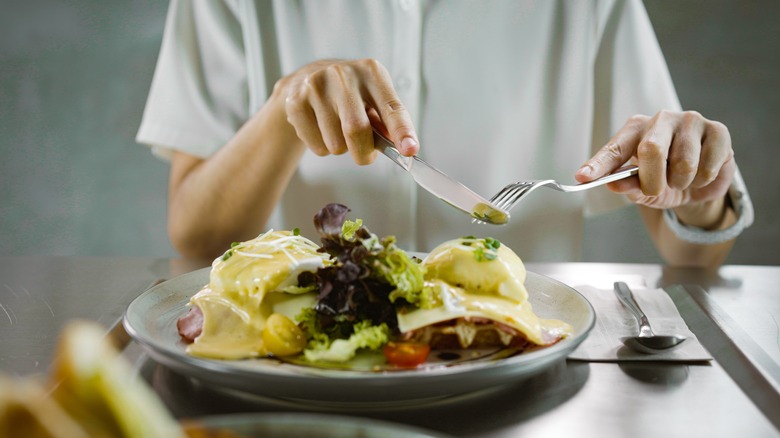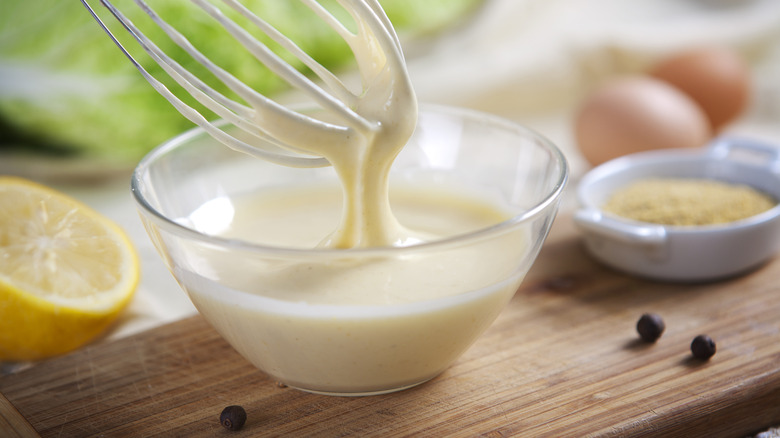The Safety Reason Anthony Bourdain Hated Hollandaise Sauce
It's the rich, golden-yellow sauce that is often drizzled over eggs Benedict — a menu staple of many well-meaning brunch spots. But can the classic Hollandaise sauce be a dangerous addition to your weekend indulgence? Experts, including Anthony Bourdain, unfortunately, say yes. It might be surprising that the adventurous chef, who tried everything from maggot fried rice to pig-blood soup, would shy away from something as commonplace as Hollandaise, but he had some good, mostly microscopic, reasons.
Hollandaise sauce is made using melted butter and raw egg yolks, which can pose a salmonella risk. Foodborne illness becomes even more of a concern when you consider the warmth and relative freshness of this popular brunch topping. Bourdain's main gripe with Hollandaise was that in many restaurants it is usually prepared ahead of time, not to order, and held at a lukewarm temperature until served.
To avoid a lumpy sauce, the egg and butter emulsion must be kept between 120 and 145 degrees Fahrenheit; a range that sits right on the upper cusp of what the USDA refers to as the 'danger zone.' Foods between 40 and 140 degrees are an ideal breeding ground for bacteria. After only 20 minutes at these temperatures, the numbers of these microbes can as much as double.
When is Hollandaise sauce safe to eat?
The safest time to enjoy Hollandaise sauce is when it is prepared fresh, ideally with the use of pasteurized eggs that have been heated in their shells low and slow enough to kill bacteria without cooking the egg. But even when using pasteurized ingredients, the sauce is still best consumed within one and a half hours of its creation.
Some restaurants make their Hollandaise in small batches or fresh to order, reducing the risks associated with lengthy holding temperatures. Restaurants might also use pre-packaged versions of the sauce that can be heated to a safe 165 degrees Fahrenheit. All these numbers and precautions might sound nit-picky, but even Anthony Bourdain knew it's always best to err on the side of caution when faced with potential hotbeds of bacteria.
Because sanitary ingredients and freshness are the two major concerns for Hollandaise sauce safety, the easiest way to ensure you can enjoy it without worry is to whip it up yourself. Try your hand at some classic Canadian eggs Benedict if you want to avoid the potentially risky restaurant dish. Make sure your eggs are stored safely in the fridge, and if keeping for later use, cool the sauce quickly and refrigerate in an airtight container for up to two days.
Alternatives to Hollandaise sauce
If you want to bypass the risk of raw eggs altogether, some equally delicious alternatives to Hollandaise can easily replace the classic sauce. Béchamel is another French favorite that is made from melted butter, milk, and flour. It takes a dash of patience to prepare, as the milk must be whisked slowly into the flour and butter mixture to avoid clumping, but the creamy white gold is worth the wait.
You can also combine mayonnaise, Dijon mustard, melted butter, lemon juice, and cayenne pepper for an easy, no-cooking-required mock-up of traditional Hollandaise. For something greener, a blender full of avocado, lemon juice, and warm water will make for a creamy, avant-garde breakfast topping.
If you are still pining for the real deal, make Hollandaise in half the time by opting for a powdered store-bought mix that nixes the need for raw egg. Some powders are all-together egg-free, and many grocery stores offer shelf-stable containers of pre-made Hollandaise that need only be heated and served. As always, pay attention to safe handling, cooking, and storage instructions so you can enjoy your meal without worry.



